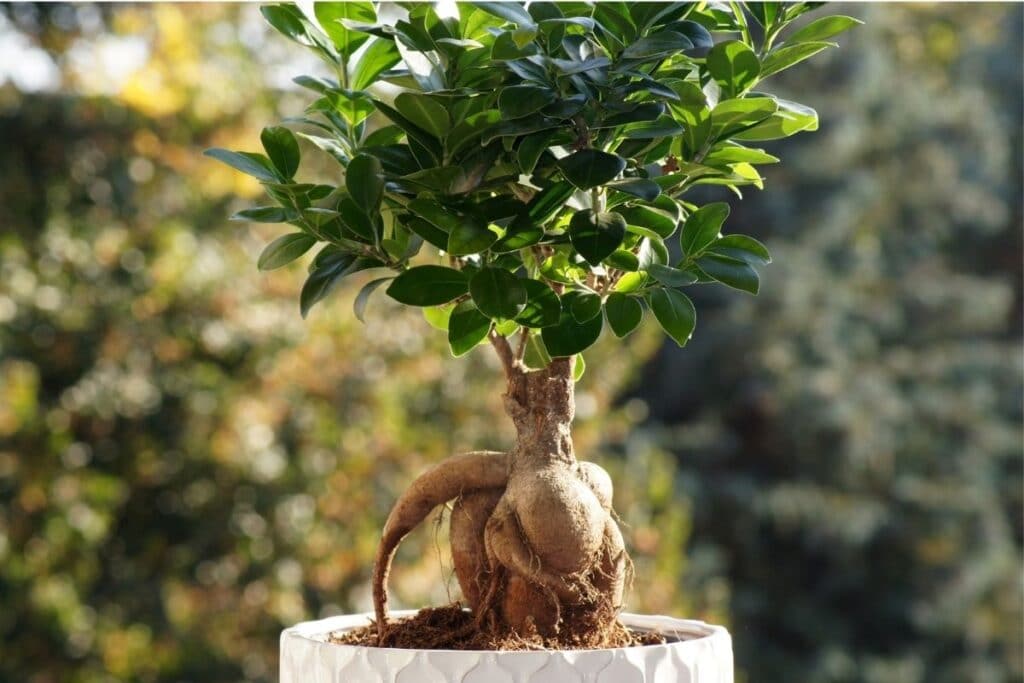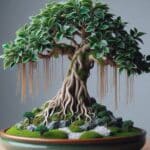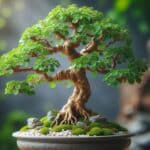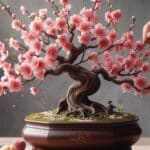Ficus microcarpa, Taiwan ficus, Banyan fig, or Ginseng ficus, is a popular species of tree used for bonsai. Although it is frequently confused with Ficus retusa, it is actually a member of the fig family, Moracaea. Native to China and other areas of tropical Asia (as well as Australia), this species is often grown as a shade tree.
However, ficus ginseng bonsai is an appealing specimen that you need to consider growing. It is tropical and has a beautiful trunk with numerous roots, making it a good choice for bonsai. It grows well indoors and has dense foliage. It is a plant of many names, including laurel fig, laurel rubber, Chinese banyan, and Indian laurel fig.
Ginseng ficus bonsai gets its name from its attractive growth habit. Its unique pot-bellied trunk is thick and gnarled, looking much like a ginseng root. It is part of the Ficus species, which includes up to 2000 different kinds of ficus plants (including Ficus retusa, another popular choice for bonsai and one with which ginseng ficus bonsai, or Ficus microcarpa, is often grafted).
Here is what you need to know about ficus microcarpa ginseng bonsai.
Interesting Facts about Ginseng Ficus Bonsai
| Height | 3-10 inches |
| Width | 2-8 inches |
| Sunlight | Full sunlight |
| Flowering Time Length | Flowers inconspicuously in the winter |
| Lifespan | 50-150 years |
| Scientific Name | Ficus microcarpa |
Growing Ginseng Ficus Bonsai from Seed or by Propagation
The best way to cultivate new ginseng ficus bonsai is by taking cuttings in the middle of the summer. You can also do air layering in the spring, which is also the best time to plant ficus seeds.
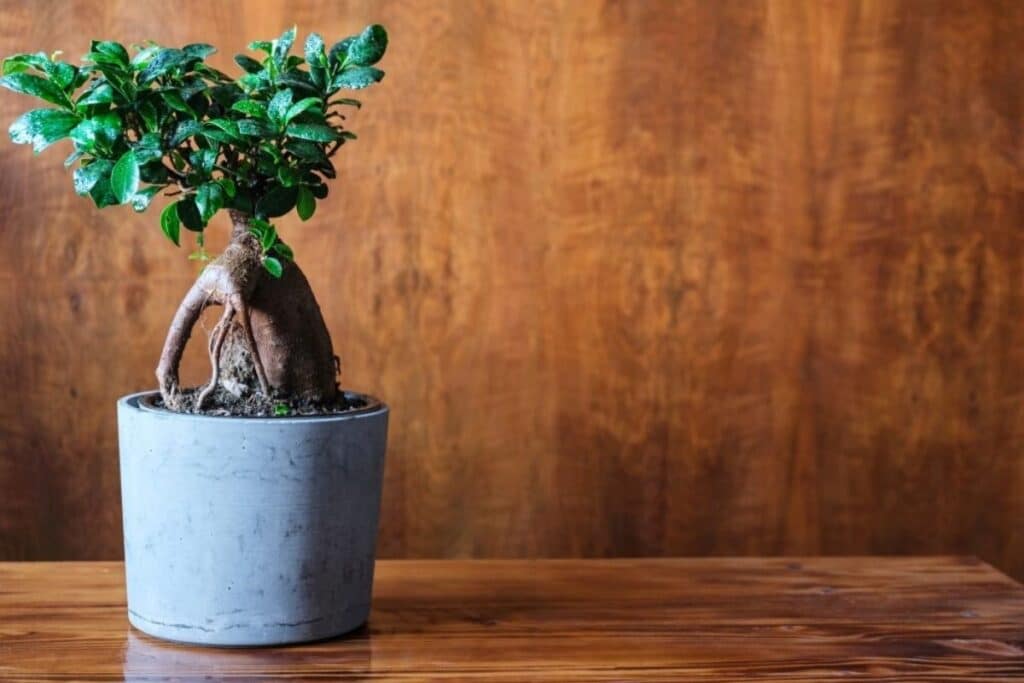
Ficus Bonsai Care Guide
Soil
Use well-draining bonsai soil for your Ginseng Ficus Bonsai to prevent waterlogging and root rot. A mix of akadama, pumice, and lava rock, or a commercial bonsai soil mix, works well.
Sunlight
Ficus Ginseng likes indirect bright light. Place your bonsai near a window where it can receive plenty of natural light, but protect it from direct sunlight, especially during the hottest part of the day. Rotate your indoor bonsai regularly to ensure even growth and prevent one-sided development.
Watering
Water your ficus plants thoroughly when the top inch of soil feels dry to the touch. When the top inch of soil on your Ginseng Ficus Bonsai feels dry to the touch, give it a lot of water.
Make sure that the whole root ball is wet by watering it evenly until the water drains from the bottom of the pot. Root rot can happen if you water too much. Change how often you water based on the weather and the time of year.
Fertilizing
Fertilize your ficus bonsai trees once every two weeks during the summer and about once every four weeks in the winter, provided that its growth does not stop. You can use a liquid fertilizer or an organic fertilizer pellet.
Potting and Repotting
Repot your ficus trees every 1-2 years to refresh the soil, prevent root binding, and promote healthy growth. Repotting is typically done in spring before the growing season begins.
Ensure that the new pot has proper drainage holes. Gently remove the bonsai from its pot, prune the tree’s roots, and replant it in fresh bonsai soil. Trim back any excess foliage to reduce stress on the plant.
See more: how to take care of a bonsai tree
Pruning Ginseng Ficus Bonsai
Prune your ginseng ficus bonsai often to help retain its shape. You should prune two leaves after six to eight have grown. This kind of pruning, known as defoliation, will help reduce leaf size. You can forego all pruning if you want your tree to develop a thickened trunk.
You can also wire and bend thin branches, since these are quite flexible, but you should check the branches often to make sure the wires aren’t cutting into the dark. You can use other unique training techniques like approach grafting with your fig trees, too.
Pests and Diseases
Ginseng ficus bonsai, like other plants in the fig family, tend to be quite resistant to pests. However, you do need to keep an eye out for risk factors for certain pests and diseases, particularly during the winter months.
For instance, dry air and poor sunlight levels can cause your plant to become weak and result in leaf drop. You may also notice issues at this time (caused by a weakening of the plant) like scale and spider mites infestations.
Supplementing with grow lights during the winter and regularly misting the leaves will help your plant recover. You can use an insecticide to get rid of the pests, too.
Where to Buy Ginseng Ficus Bonsai
You should be able to find ginseng ficus bonsai plants for sale as potted plants at just about any nursery or gardening store. However, you will have better luck purchasing bonsai from specialized traders, who will sell plants that are well cared for and haven’t been poorly grafted. Choose these to make sure your plants grow optimally.
FAQs
Does ginseng ficus need sunlight?
Yes, Ginseng Ficus prefers bright, indirect sunlight but can tolerate some direct sunlight, especially in the morning or late afternoon. However, prolonged exposure to intense sunlight may cause its leaves to scorch.
Why does my Ginseng bonsai lose leaves?
Ginseng bonsai may lose leaves due to various reasons, including overwatering, underwatering, sudden changes in temperature or humidity, insufficient light, pests, diseases, or root issues. Assessing factors such as watering practices, light levels, soil condition, and environmental conditions can help determine the cause and appropriate corrective actions.
What do you feed a Ficus Ginseng bonsai tree?
Fertilize a Ficus Ginseng bonsai tree with a balanced liquid fertilizer diluted to half-strength during the growing season (spring and summer) every 2-4 weeks. Reduce fertilization frequency or switch to a low-nitrogen fertilizer during the dormant season (fall and winter).
How often do you water a ginseng bonsai?
Water a Ginseng bonsai when the top inch of soil feels dry, typically every 2-3 days during the growing season and less frequently during the dormant season. Adjust watering frequency based on factors such as temperature, humidity, pot size, and soil drainage to prevent overwatering or underwatering.
How do I make my Ficus Ginseng bushy?
To make your Ficus Ginseng bonsai bushy, regularly prune the top growth to encourage branching and stimulate new growth. Pinch or trim back the new growth to promote compact growth and maintain the desired shape. Additionally, consider repotting the bonsai every 2-3 years to refresh the soil and promote healthy root growth.
Feel free to check other types of ficus bonsai.
References
Reference list:
1. Indian Laurel Fig or Chinese Banyan (n.d.) California Polytechnic Institute Urban Forest Ecosystems Institute. Retrieved from: https://selectree.calpoly.edu/tree-detail/ficus-microcarpa
Close
*image by Wirestock/depositphotos

